Critical Art Ensemble (1994-2006)
Filed under book | Tags: · activism, art, biotechnology, control society, copyright, cultural resistance, tactical media, transgenics, virtuality
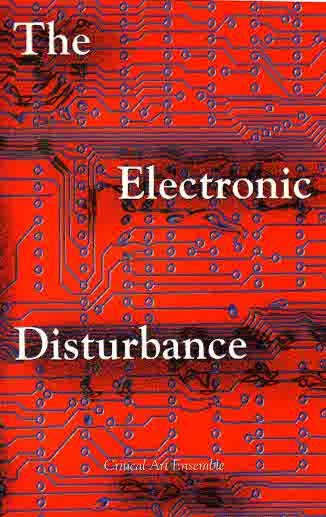
The Electronic Disturbance (1994)
The Critical Arts Ensemble is a virtual collective. This collection of essays and short pieces examines the changing rules of cultural and political resistance: “The current technological revolution has created a new geography of power relations — as data, human beings confront an authoritarial impulse that thrives on absence. As a virtual geography of cognizance and action, resistance must assert itself in electronic space.”
Publisher Autonomedia, May 1994
ISBN 1570270066

Electronic Civil Disobedience and Other Unpopular Ideas (1997)
In the age of global, nomadic capital, the CAE attempts to lay the foundation for the growth of nomadic resistance. Utilizing the tools of its enemy, the CAE suggests that a new cultural and political resistance is possible. Fusing a situationist-influenced concept of contestational art, an understanding of the parallel nature of cultural and political action borrowed from Gramsci, and a hacker’s deep understanding of how new technology functions, ECD is a launch point for debating the nature of power and resistance in the information age.
Publisher Autonomedia, May 1997
ISBN 9781570270567
commentary (Stefan Wray)
authors
publisher
PDF
View online, cont. (La Résistance électronique et autres idées impopulaires, French)
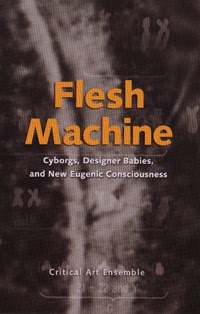
Flesh Machine: Cyborgs, Designer Babies, and New Eugenic Consciousness (1998)
Having elsewhere explored the dimensions of social and political control in electronic culture, the Critical Arts Ensemble here turns full frontal towards the body, arguing that utopian promises of virtuality are simple distractions from the real project: the deployment of biotechnologies upon the bodies of citizens in the service of the transnational order.
Publisher Autonomedia, March 1998
ISBN 9781570270673
PDF
PDF (Η μηχανή της σάρκας: Εκδόσεις των ξένων, Greek)
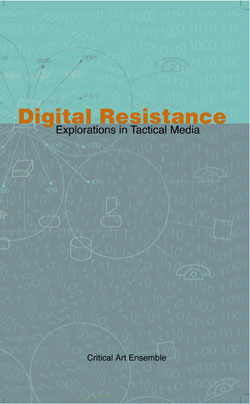
Digital Resistance: Explorations in Tactical Media (2000)
Essays in cultural politics and technology from the collective authors of Electronic Disturbance, Electronic Civil Disobedience and Flesh Machine. Chapters in this new volume include “Electronic Civil Disobedience and the Public Sphere,” “The Mythology of Terrorism on the Net,” “The Promissory Rhetoric of Biotechnology,” “Observations on Collective Cultural Action,” “Recombinant Theater and Digital Resistance,” “Contestational Robotics,” “Children as Tactical Media Participants,” and “The Financial Advantages of Anti-Copyright.”
Publisher Autonomedia, April 2000
ISBN 1570271194
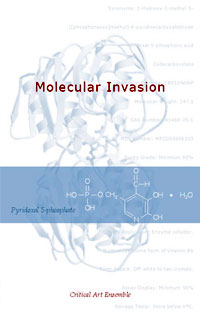
The Molecular Invasion (2002)
Having exhausted the possibilities for geographic colonial expansion, as well as reaching the fiscal limitations of virtual space, capital begins its invasion of a new frontier — organic molecular space. The Critical Art Ensemble began mapping this development in Flesh Machine (Autonomedia, 1998) by examining the use of reproductive technologies and their promise for achieving an intensified degree of control over worker and citizen. The Molecular Invasion acts as a companion to this first book by mapping the politics of transgenics, and offering a model for the creation of a contestational biology, as well as providing direct interventionist tactics for the disruption of this new assault on the organic realm.
Publisher Autonomedia, April 2002
ISBN 1570271380, 9781570271380
140 pages
PDF
PDF (Molekularna invazija, Croatian)
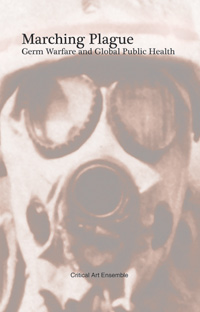
Marching Plague: Germ Warfare and Global Public Health (2006)
The sixth Critical Art Ensemble book offers a radical reframing of the rhetoric surrounding germ warfare. After refuting the idea that massive biological attack is a probable future occurrence, the book goes on to argue that biological weapons programs primarily serve the economic interests of the military-security complex, squandering resources needed to fight the massive loss of life each year from emerging infectious diseases. The book also includes two appendices examining the case of the U.S. Justice Department against Steve Kurtz, for which the original manuscript of the book was seized in the state’s investigation.
Publisher Autonomedia, 2006
ISBN 157027178X, 9781570271786
148 pages
review (Randall Packer)
authors
publisher
Anna Bentkowksa-Kafel, Trish Cashen, Hazel Gardiner (eds.): Futures past: thirty years of arts computing (2007)
Filed under book | Tags: · art history, digital art, software art

In decades past, artists envisioned a future populated by technological wonders such as hovercraft vehicles and voice-operated computers. Today we barely recognize these futuristic landscapes that bear only slight resemblance to an everyday reality. Futures Past considers digital media’s transformative impact on the art world from a perspective of thirty years’ worth of hindsight. Herein a distinguished group of contributors—from researchers and teachers to curators and artists—argue for a more profound understanding of digital culture in the twenty-first century.
This unprecedented volume examines the disparities between earlier visions of the future of digital art and its current state, including frank accounts of promising projects that failed to deliver and assessments of more humble projects that have not only survived, but flourished. Futures Past is a look back at the frenetic history of computerized art that points the way toward a promising future.
Published by Intellect Books, 2007
ISBN 1841501689, 9781841501680
128 pages
Key terms:
ARTstor, ontologies, Semantic Web, UCSD, iconography, art history, WordNet, digital art, Toyo Ito, Charles Rufus Morey, Princeton University, Kersale, synsets, University of Birmingham, Christian Art, Georg Nees, Medieval Art, software art, Jean Nouvel, intranet
More info (google books)
More info (publisher)
MIT Comparative Media Studies student theses (2001-2008)
Filed under thesis | Tags: · cartography, curating, data visualisation, internet art, media culture, net art, politics
AMANDA FINKELBERG
Space, Place, and Database: Digital Cartography in the Network Age (2007)
This paper addresses the changes in cartography since digitization and widespread popular dissemination. Cybercartography, an emergent system of maps, mapmaking tools, and mapmakers, forces a rethinking of spatial representations. The implicit distinction in digital media enables a new type of map user or neo-geographer that creates layers of expressions based on subjective experience. This paper argues that the neogeographer signifies a new cartographic behavior that affords a complex subjectivity. This behavior is further exhibited in the practice of navigable maps and virtual globes which lead the way to a paradigmatic change in the way we represent and interact with space. It is divided into three parts: Part I addresses the role of digitization in maps and lays out framework and vocabulary. Part II examines layers of spatial representations in historical context. Part III opens room for future study in the quickly developing inhabitable cartographic spaces of virtual globes and virtual worlds.
PDF
KAREN VERSCHOOREN
.art: situating internet art in the modern museum (2007)
This thesis provides a critical analysis of the relation between Internet art and the traditional institution for contemporary art in the North American and West-European regions. Thirteen years after its inception as an art form, the Internet art world finds itself in a developmental stage and its relation to the traditional institution for contemporary art is accordingly. Through an elaborate discussion of the key players, institutions and discourses on aesthetics, economics and exhibition methodologies, this sociological analysis of the past and current situation hopes to offer a solid ground for extrapolation and predictions for Internet art’s future as an art world in its relation to the traditional art institutions.
PDF
STEPHANIE DAVENPORT
Experiments in Corporate Collaboration: The Case of the Ars Electronica FutureLab (2003)
PDF
SOPHIE ORMEROD
The Medium Still Isn’t the Message: Revisiting the Link Between Communication Technologies and Political Liberalization (2002)
PDF

